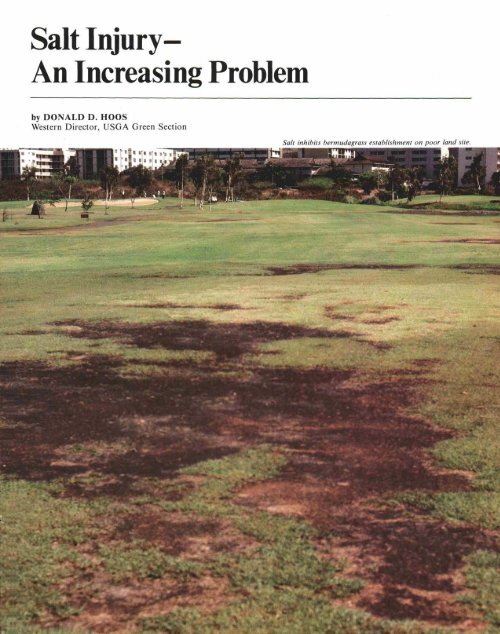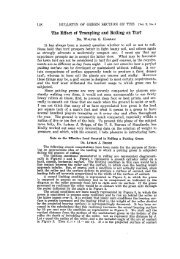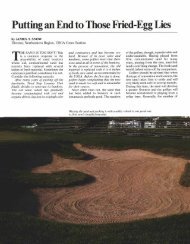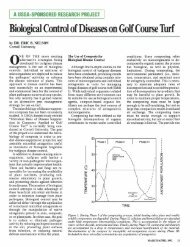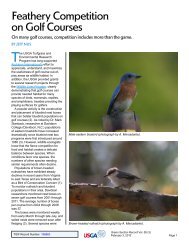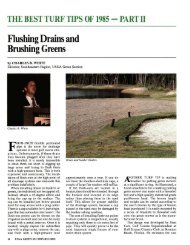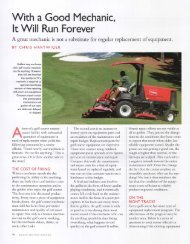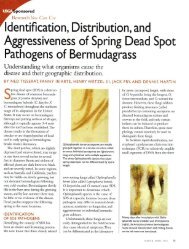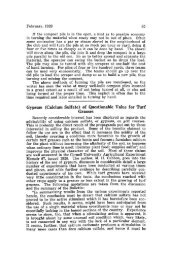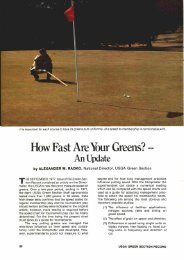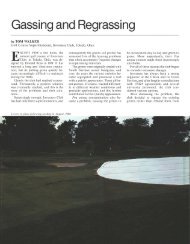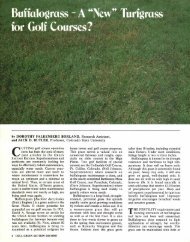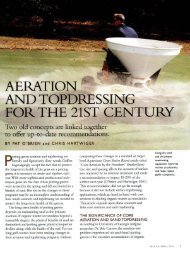Salt Injury -- an Increasing Problem - USGA Green Section Record
Salt Injury -- an Increasing Problem - USGA Green Section Record
Salt Injury -- an Increasing Problem - USGA Green Section Record
- No tags were found...
You also want an ePaper? Increase the reach of your titles
YUMPU automatically turns print PDFs into web optimized ePapers that Google loves.
<strong>Salt</strong> <strong>Injury</strong>-An <strong>Increasing</strong> <strong>Problem</strong>by DONALD D. HOOSWestern Director, <strong>USGA</strong> <strong>Green</strong> <strong>Section</strong><strong>Salt</strong> inhibits bermudagrass establishment on poor l<strong>an</strong>d site.tWIt"-ottsrrA-*-:
APROBLEM OF increasing occurrencein Southern California <strong>an</strong>dother areas of the Southwest isestablishing <strong>an</strong>d maintaining turfgrassesin areas of poor soil quality. This isparticularly true of establishing grassesin areas of high salt accumulation. More<strong>an</strong>d more golf courses are being builton sites unsuitable for <strong>an</strong>y other purpose.Soil conditions on these sites areusually less th<strong>an</strong> ideal. On the aridsolstypically found in the Southwest, m<strong>an</strong>ysites used for golf courses are high inclay content with a great deal of calciumcarbonate or gypsum present in theform of caliche. The soil pH is usuallybetween 7.0 <strong>an</strong>d 8.0 on these soils. Ifwater used for irrigation is high insodium, its combination with the aridsolsc<strong>an</strong> be a problem.<strong>Problem</strong>s occur when sodium c<strong>an</strong>notbe leached below the root zone of thegrass pl<strong>an</strong>t. Poor drainage in these claysoils is often a problem on poor l<strong>an</strong>dsites used for golf course construction.Because of the high salt content of bothirrigation water <strong>an</strong>d the soil, sodiumhas a tendency to accumulate at the soilsurface. Evaporation rates in the Southwesttend to be high, <strong>an</strong>d this furtheraccentuates salt accumulation at thesoil surface.The use of effluent water for irrigationalso adds to the problem of salt accumulation.Because of evaporation duringthe holding process as water movesfrom domestic use to the effluent processingpl<strong>an</strong>ts, sodium levels becomemore concentrated. Effluent watergenerally has slightly higher sodiumlevels th<strong>an</strong> subsurface water used forirrigation. The combined use of poorl<strong>an</strong>d sites <strong>an</strong>d effluent water for irrigationof new golf course developmentsshould be carefully screened for identificationof salt-related problems.High salt levels affect turfgrassvisually by causing wilting <strong>an</strong>d a bluegreenappear<strong>an</strong>ce, followed by irregularstunting of growth. Tip burn is oftenpresent. An <strong>an</strong>aerobic layer is oftenformed in the upper root zone <strong>an</strong>dthatch layer. This layer is typically blackin color <strong>an</strong>d exudes a readily identifiableodor. Under these conditions, lessoxygen enters the root zone to promoteaero bic microbial activity. Growth ofroots in this layer is quite difficult, evenfor bermudagrass.brings us to the major method in solvingestablishment <strong>an</strong>d m<strong>an</strong>agement problemsunder sodium conditions - drainage<strong>an</strong>d leaching. If drainage c<strong>an</strong> beimproved to allow sufficient movementof water through the root zone <strong>an</strong>d toleach accumulated salts, there is a betterch<strong>an</strong>ce to avoid salt problems. If waterc<strong>an</strong> penetrate <strong>an</strong>d move through the soilprofile, there is less evaporation nearthe soil surface <strong>an</strong>d thus less accumulationof sodium in the root zone.Therefore, one of the first stepstoward correcting a sodium problemshould be to seek ways of improvingdrainage in <strong>an</strong>y affected areas. Installationof French drains may be sufficient;other areas may need recontouring toallow surface drainage away from lowspots. In some cases, redesign of theirrigation system may be needed. Relocationof sprinkler heads may also beneeded to solve a sodium problem inlow areas in front of greens. The overlapof green <strong>an</strong>d fairway sprinkler heads inlow areas in front of greens often resultsin accumulation of excess sodium.Often, by moving heads or reprogrammingof the irrigation sequence, thisproblem c<strong>an</strong> be overcome withoutadditional measures.Aeration<strong>Salt</strong> injury on bermudagrass has appear<strong>an</strong>ce of being diseased.Another import<strong>an</strong>t process in establishing<strong>an</strong>d maintaining grasses in highsodium areas is to aerate <strong>an</strong>d cultivateaffected areas regularly. The coringprocess relieves compaction <strong>an</strong>dimproves water penetration. It alsoencourages oxygen exch<strong>an</strong>ge in the rootzone <strong>an</strong>d helps prevent <strong>an</strong>aero bicconditions from developing.AmendmentsMost of the soils in the Southwest aretypically high in calcium. For thisreason, m<strong>an</strong>y of the soils exhibitingsodium problems do not respond togypsum applications. In some cases,gypsum will modify the effects ofirrigation water high in sodium <strong>an</strong>d theturfgrass will benefit. This is especiallytrue on s<strong>an</strong>d <strong>an</strong>d in putting greens.Acidifying the soil with sulfur or sulfurcontainingmaterials will produce themost dramatic results in solving sodiumproblems. The sulfur tends to improvethe soil's infiltration rate by dissolvingcalcium carbonates which accumulateon the soil particles <strong>an</strong>d act as pluggingagents. Lowering the soil pH as a resultof regular sulfur applications also tendsDrainageUnder high salt conditions, poorquality turfgrass develops in low spots<strong>an</strong>d in poorly drained areas wheresodium concentration is greatest. This2 <strong>USGA</strong> GREEN SECTION RECORD
New salt-toler<strong>an</strong>t grasses are being developed.to make needed soil nutrients, such asiron <strong>an</strong>d phosphorus, more available tothe turfgrass pl<strong>an</strong>t.Grass VarietyChoosing the right grass variety for useunder high salt conditions is <strong>an</strong>otherimport<strong>an</strong>t consideration. There is nodou bt that certain grasses tolerate muchhigher levels of salt th<strong>an</strong> others. A greatdeal of research is being directed towarddeveloping grasses that tolerate higherlevels of salt th<strong>an</strong> grasses presentlyavailable. In the past few years, severalnew grasses have been released thathave a high toler<strong>an</strong>ce for sodium. Fultsalkaligrass was released by ColoradoState University several years ago.Under cool season grass conditions, itdoes remarkably well at higher saltlevels. Adelaide <strong>an</strong>d Futurf, varieties ofPaspalum vaginatum, are warm seasongrasses that also tolerate relatively highlevels of sodium. Their appear<strong>an</strong>ce <strong>an</strong>dgrowth habits are similar to commonbermudagrass. Research is being conductedat the University of California(Riverside) on these grass varieties todetermine the effects of commonm<strong>an</strong>agement practices on their growth<strong>an</strong>d establishment.Of presently available grasses for useon golf courses, the bermudagrasseshave the best toler<strong>an</strong>ce for sodium. Ofthe cool season grasses, creeping bentgrasseshave a higher salt toler<strong>an</strong>ce th<strong>an</strong>perennial ryegrasses or Kentucky bluegrasses.All have a higher salt tol~r<strong>an</strong>ceth<strong>an</strong> Poa <strong>an</strong>nua. Seaside creeping bentgrasshas a higher salt toler<strong>an</strong>ce th<strong>an</strong>Penncross.Relative<strong>Salt</strong>Toler<strong>an</strong>ceGoodMediumPoorTurfgrassBermudagrassZoysiagrassCreeping bentgrassTall fescuePerennial rye grassRed fescueKentucky bluegrassColonial bentgrassCentipedegrassSummaryThe turfgrass species, soil texture <strong>an</strong>ddepth of the salt concentration in thesoil profile are all factors th<strong>an</strong> c<strong>an</strong> affectturfgrass growth under high salt concentrations.A high salt concentrationimpairs the absorption of water <strong>an</strong>dessential pl<strong>an</strong>t nutrients. Impaired seedgermination <strong>an</strong>d poor vegetative establishmentare often encountered whenhigh sodium conditions exist. Physicalproperties of the soil are also alteredwhen sodium levels are high. Sodiumcauses detlocculation of the soil colloids.This c<strong>an</strong> lead to a reduction in soilaeration which increases susceptibilityto compaction <strong>an</strong>d decreases waterinfiltration rates.The best solution to sodium pro blemsis to leach away the excess sodiumthrough improved drainage <strong>an</strong>dincreased aeration of pro blem areas.Soil amendments to acidify the areamay be beneficial if leaching of excesssodium c<strong>an</strong> also be achieved.NOVEMBER/DECEMBER 1981 3


